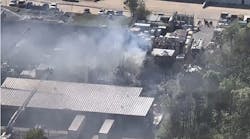Unfortunately, it seems like every other week I hear a news story about a medical helicopter crashing or some other tragic event involving a medical helicopter. As of this writing, the latest incident involved a medical helicopter that crashed in mid-October in Aurora, IL, when it clipped a radio tower support wire. All four people onboard were killed, including a year-old child being transported to Children's Memorial Hospital in Chicago. Several days earlier, a paramedic who worked for the Arizona Department of Public Safety was struck and killed by the rotor blade of a medical helicopter while he was attempting to perform a rescue.
These are just two in a string of events involving medical helicopters in the past year. According to the Associated Press, in less than a year, there have been nine crashes involving medical helicopters in the U.S., resulting in 35 deaths.
Medical helicopter companies have expanded rapidly since the late 1990s, when the companies began competing in urban areas and demand for air ambulance services increased in rural areas where hospitals had been shut down. Since 2000, it is estimated that the number of medical helicopters operating in the U.S. has increased by 50%, from 500 to about 750.
In October 2008, responding to the increase in these crashes, the National Transportation Safety Board (NTSB) issued its 2009 Federal Most Wanted List of Safety Improvements. Newly added to the list of 15 areas of concern was to "Improve Emergency Medical Services (EMS) Flight Operations." The NTSB said that the Federal Aviation Administration (FAA) is not responding fast enough to the board's 2006 proposals to prevent such crashes. The NTSB made four recommendations to reduce them. One would require EMS helicopters to be outfitted with Terrain Awareness Warning Systems (TAWS). The system warns pilots in danger of crashing into the ground, hills, mountains, buildings or something else. Some EMS helicopters in the U.S. carry these systems, but it is not required. Another recommendation is that EMS flights that carry only medical personnel follow more stringent safety rules. According to the Associates Press, 10 crashes between January 2002 and January 2005 involving aircraft that carried only medical personnel could have been prevented if more rigorous rules had been followed.
Another recommendation calls for a formal flight-risk evaluation before an EMS flight. The NTSB said that 15 of 55 crashes that occurred between January 2002 and January 2005 could have been prevented if this procedure had been used. The NTSB also recommends that EMS flights use a formal dispatch procedure that includes up-to-date weather data and aid in flight risk-assessment decisions.
There is also much debate within the EMS community concerning the reason why medical helicopter crashes have increased: Is it because the helicopters are being used more often and unnecessarily? I have heard of patients being transported by medical helicopter to a hospital only to be treated and released before the medical helicopter has even left to return to its base. I also have heard of aggressive marketing campaigns by medical helicopter companies that encourage paramedics to call for helicopters. And, unfortunately, unless the EMS system has a protocol in place for when to call for a helicopter, discretion rests solely with the paramedic.
Some medical studies have questioned the need for many air-ambulance flights. A 2002 study in The Journal of Trauma found that helicopters were used "excessively" for patients who were not severely injured, and often did not transport patients to the hospital any faster than ground ambulances.
A review by The Baltimore Sun of crash records and other documents on the 26 fatal medevac crashes in the U.S. since 2003 shows that many did not involve urgent, minutes-from-death missions. At least eight involved patients who waited longer for a helicopter than a ground ambulance might have needed to drive them to a hospital. And at least six flights were for patients who were discharged soon after helicopters dropped them off at a hospital or who survived lengthy ambulance rides after the helicopters sent for them went down. Half of the 26 fatal medevac accidents occurred during missions to transfer patients between hospitals - one for a distance of 10 miles - and many of the transferred patients waited hours from the time a helicopter was called until it arrived and was ready to take off again, records show.
Why have we seen such an increase in these flights? One reason may be financial. Air-ambulance companies receive roughly $7,500 per flight from insurance companies or Medicare.
There is no doubt that medical helicopters have saved many lives, starting from when they started evacuating the wounded off the battlefields of Korea in the 1950s up to the present day. But the number of accidents is a definite indication that something is broken and needs to be fixed. Hopefully, those fixes will come soon.
GARY LUDWIG, MS, EMT-P, a Firehouse® contributing editor, is a deputy fire chief with the Memphis, TN, Fire Department. He has 30 years of fire-rescue service experience. Ludwig is chairman of the EMS Section for the International Association of Fire Chiefs (IAFC), has a master's degree in business and management, and is a licensed paramedic. He is a frequent speaker at EMS and fire conferences nationally and internationally, and can be reached through his website at www.garyludwig.com.





